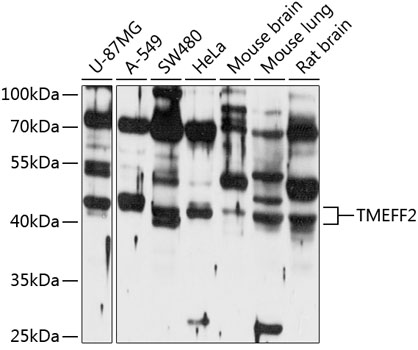Cell Biology Antibodies 1
Anti-TMEFF2 Antibody (CAB10464)
- SKU:
- CAB10464
- Product Type:
- Antibody
- Reactivity:
- Human
- Reactivity:
- Mouse
- Reactivity:
- Rat
- Host Species:
- Rabbit
- Isotype:
- IgG
- Antibody Type:
- Polyclonal Antibody
- Research Area:
- Cell Biology
Description
| Antibody Name: | Anti-TMEFF2 Antibody |
| Antibody SKU: | CAB10464 |
| Antibody Size: | 20uL, 50uL, 100uL |
| Application: | WB |
| Reactivity: | Human, Mouse, Rat |
| Host Species: | Rabbit |
| Immunogen: | Recombinant fusion protein containing a sequence corresponding to amino acids 41-320 of human TMEFF2 (NP_057276.2). |
| Application: | WB |
| Recommended Dilution: | WB 1:500 - 1:2000 |
| Reactivity: | Human, Mouse, Rat |
| Positive Samples: | U-87MG, A-549, SW480, HeLa, Mouse brain, Mouse lung, Rat brain |
| Immunogen: | Recombinant fusion protein containing a sequence corresponding to amino acids 41-320 of human TMEFF2 (NP_057276.2). |
| Purification Method: | Affinity purification |
| Storage Buffer: | Store at -20'C. Avoid freeze / thaw cycles. Buffer: PBS with 0.02% sodium azide, 50% glycerol, pH7.3. |
| Isotype: | IgG |
| Sequence: | FPTS LSDC QTPT GWNC SGYD DREN DLFL CDTN TCKF DGEC LRIG DTVT CVCQ FKCN NDYV PVCG SNGE SYQN ECYL RQAA CKQQ SEIL VVSE GSCA TDAG SGSG DGVH EGSG ETSQ KETS TCDI CQFG AECD EDAE DVWC VCNI DCSQ TNFN PLCA SDGK SYDN ACQI KEAS CQKQ EKIE VMSL GRCQ DNTT TTTK SEDG HYAR TDYA ENAN KLEE SARE HHIP CPEH YNGF CMHG KCEH SINM QEPS CRCD AGYT GQHC EKKD YSVL YVVP GPVR FQYV |
| Gene ID: | 23671 |
| Uniprot: | Q9UIK5 |
| Cellular Location: | Membrane, Secreted, Single-pass type I membrane protein, Single-pass type I membrane protein |
| Calculated MW: | 19kDa/38kDa/41kDa |
| Observed MW: | 41kDa |
| Synonyms: | TMEFF2, CT120.2, HPP1, TENB2, TPEF, TR, TR-2 |
| Background: | This gene encodes a member of the tomoregulin family of transmembrane proteins. This protein has been shown to function as both an oncogene and a tumor suppressor depending on the cellular context and may regulate prostate cancer cell invasion. Multiple soluble forms of this protein have been identified that arise from both an alternative splice variant and ectodomain shedding. Additionally, this gene has been found to be hypermethylated in multiple cancer types. Alternative splicing results in multiple transcript variants. |
| UniProt Protein Function: | TMEFF2: may be a survival factor for hippocampal and mesencephalic neurons. The shedded form up-regulates cancer cell proliferation, probably by promoting ERK1/2 phosphorylation. A member of the Cancer-Testis Antigen (CTA) superfamily. CTAs may play roles in embryonal development and tumor transformation or aspects of tumor progression. CTAs were once thought to be silenced in most normal adult tissues, with limited expression in fetal, placental, testis, and ovarian cells. These proteins are now known to be aberrantly expressed in various cancers and many are capable of eliciting humoral and cellular immune responses. Highly expressed in adult and fetal brain, spinal cord and prostate. Expressed in all brain regions except the pituitary gland, with highest levels in amygdala and corpus callosum. Expressed in the pericryptal myofibroblasts and other stromal cells of normal colonic mucosa. Expressed in prostate carcinoma. Down-regulated in colorectal cancer. Present in Alzheimer disease plaques. Down-regulated in tumor cell lines in response to a high level of methylation in the 5' region. The CpG island methylation correlates with TMEFF2 silencing in tumor cell lines. Belongs to the tomoregulin family. Three isoforms of the human protein are produced by alternative splicing. Isoform three is expressed weakly in testis and at high levels in normal and cancerous prostate. Note: This description may include information from RefSeq and UniProtKB |
| UniProt Protein Details: | Protein type:Cancer Testis Antigen (CTA); Cell surface; Membrane protein, integral Chromosomal Location of Human Ortholog: 2q32.3 Biological Process: negative regulation of cell migration; negative regulation of integrin biosynthetic process; negative regulation of stress fiber formation |
| NCBI Summary: | This gene encodes a member of the tomoregulin family of transmembrane proteins. This protein has been shown to function as both an oncogene and a tumor suppressor depending on the cellular context and may regulate prostate cancer cell invasion. Multiple soluble forms of this protein have been identified that arise from both an alternative splice variant and ectodomain shedding. Additionally, this gene has been found to be hypermethylated in multiple cancer types. Alternative splicing results in multiple transcript variants. [provided by RefSeq, Feb 2015] |
| UniProt Code: | Q9UIK5 |
| NCBI GenInfo Identifier: | 71153590 |
| NCBI Gene ID: | 23671 |
| NCBI Accession: | Q9UIK5.1 |
| UniProt Secondary Accession: | Q9UIK5,Q2FA44, Q4ZFW4, Q53H90, Q53RE1, Q8N2R5, Q9NR15 Q9NSS5, Q9P2Y9, Q9UK65, |
| UniProt Related Accession: | Q9UIK5 |
| Molecular Weight: | 41kDa |
| NCBI Full Name: | Tomoregulin-2 |
| NCBI Synonym Full Names: | transmembrane protein with EGF like and two follistatin like domains 2 |
| NCBI Official Symbol: | TMEFF2 |
| NCBI Official Synonym Symbols: | TR; HPP1; TPEF; TR-2; TENB2; CT120.2 |
| NCBI Protein Information: | tomoregulin-2 |
| UniProt Protein Name: | Tomoregulin-2 |
| UniProt Synonym Protein Names: | Hyperplastic polyposis protein 1; Transmembrane protein with EGF-like and two follistatin-like domains |
| Protein Family: | Tomoregulin |
| UniProt Gene Name: | TMEFF2 |
View AllClose




![TMEFF2 Monoclonal Antibody [PJ4B6AT] (CPAB0559) TMEFF2 Monoclonal Antibody [PJ4B6AT] (CPAB0559)](https://cdn11.bigcommerce.com/s-rd6ounxcu2/images/stencil/590x590/products/58780/63962/tmeff2-monoclonal-antibody-pj4b6at-cpab0559__15696__28817.1706535215.jpg?c=1)


